Bibliometric Analysis of Research on Soil Water from 1934 to 2019
Abstract
1. Introduction
2. Materials and Methods
2.1. Data Collection
2.2. Data Analysis Methods
3. Results and Discussion
3.1. The Evolution of Research Activity by Quantitative Analysis of Article Outputs
3.2. Analysis of Main Subject Categories and Journals
3.3. Study on International Collaboration and Geographic Distribution of Authors
3.4. The Hot Topics in SW Research
3.5. The Research Frontiers in the Field of SW
- (1)
- “Temperature”, “soil respiration”, “nitrogen”, “warming”, and other keywords related to “climate change” were included in the red cluster. As the problem of global warming becomes increasingly prominent, SW researchers have also paid more attention to spatiotemporal trends of soil moisture and the interaction between soil moisture and soil nutrient conversion under the background of global climate change [42]. Affected by meteorological factors and vegetation conditions, there are differences in the response of soil moisture to climate change in various regions. However, current soil moisture projections are almost essentially “black-box” type assessments that remain considerable uncertainties [43], which leads to discrepancies in the prediction results based on different models. Further research is needed, in terms of improving model prediction accuracy by understanding the interaction mechanism among the elements of the soil–vegetation–atmosphere system.
- (2)
- For the green cluster, researches on “drought”, “soil water stress”, “soil water-use efficiency”, “irrigation”, and “yield” mainly explored the relationship between soil water and agricultural production activities. Soil moisture drought impacts can be witnessed in irrigated agriculture, and long-term drought creates a severe threat to food security. Hence, it is critical to focus on soil moisture drought forecasting, early warning, mitigations, resilience, and recovery in future SW research [44].
- (3)
- The blue keywords cluster mainly consisting of “soil water content”, “runoff”, “bulk density”, and “organic matter”, which mostly occurred in studies of soil properties and soil water movement mechanism. The water retention capacity and hydraulic conductivity of soil are controlled by the soil structure, especially the pore size distribution [45]. Studies on quantifying the relationships between soil hydraulic properties and soil structure parameters, and revealing the effects of soil structure on soil water storage, water flow, and the solute transport are still essential in the future [46].
- (4)
- “Remote sensing”, “Moderate Resolution Imaging Spectroradiometer (MODIS)”, and “Synthetic Aperture Radar (SAR)” constituted the yellow cluster centered on “soil moisture”, mainly representing the research method of soil moisture retrieval based on remote sensing technology. Establishing multi-index or multivariate soil moisture inversion models based on multiple satellite data sets is an effective method to improve the accuracy of soil moisture monitoring, and it merits further exploration. As remote sensing inversion can only provide soil moisture data in the thin upper layers, developing a method to obtain soil moisture data in deep soil layers (e.g., plant root zone) with satellite data may be an effective approach to agriculture drought monitoring at a large spatial scale [44].
- (5)
- The research themes represented by the purple cluster centered on “evapotranspiration” were mainly related to water balance and energy balance research studies, which were generally combined with water circulation processes such as evaporation and drainage [47]. The main controlling factors of soil hydrological processes such as evapotranspiration, runoff, and infiltration are various on different spatial scales, so scaling transform is worthy of further study [48].
4. Conclusions
Author Contributions
Funding
Acknowledgments
Conflicts of Interest
References
- Sawatsky, N.; Li, X. Importance of soil-water relations in assessing the endpoint of bioremediated soils. Plant Soil 1997, 192, 227–236. [Google Scholar] [CrossRef]
- Rawls, W.J.; Pachepsky, Y.A.; Ritchie, J.C.; Sobecki, T.M.; Bloodworth, H. Effect of soil organic carbon on soil water retention. Geoderma 2003, 116, 61–76. [Google Scholar] [CrossRef]
- Li, S.; Zhou, D.; Luan, Z.; Pan, Y.; Jiao, C. Quantitative simulation on soil moisture contents of two typical vegetation communities in Sanjiang Plain, China. Chin. Geogr. Sci. 2011, 21, 723–733. [Google Scholar] [CrossRef]
- Jensen, C.R. Effect of soil water osmotic potential on growth and water relationships in barley during soil water depletion. Irrig. Sci. 1982, 3, 111–121. [Google Scholar] [CrossRef]
- Chen, H.; Qin, A.; Chai, Q.; Gan, Y.; Liu, Z. Quantification of Soil Water Competition and Compensation Using Soil Water Differences between Strips of Intercropping. Agric. Res. 2014, 3, 321–330. [Google Scholar] [CrossRef]
- Subbaiah, R. A review of models for predicting soil water dynamics during trickle irrigation. Irrig. Sci. 2013, 31, 225–258. [Google Scholar] [CrossRef]
- Bell, J.M.; Schwartz, R.C.; McInnes, K.J.; Howell, T.A.; Morgan, C.L.S. Effects of irrigation level and timing on profile soil water use by grain sorghum. Agric. Water. Manag. 2020, 232, 106030. [Google Scholar] [CrossRef]
- Bodner, G.; Nakhforoosh, A.; Kaul, H. Management of crop water under drought: A review. Agron. Sustain. Dev. 2015, 35, 401–442. [Google Scholar] [CrossRef]
- Medrano, H.; Tomás, M.; Martorell, S.; Escalona, J.; Pou, A.; Fuentes, S.; Flexas, J.; Bota, J. Improving water use efficiency of vineyards in semi-arid regions. A review. Agron. Sustain. Dev. 2015, 35, 499–517. [Google Scholar] [CrossRef]
- Nederhof, A.J. Bibliometric monitoring of research performance in the Social Sciences and the Humanities: A Review. Scientometrics 2006, 66, 81–100. [Google Scholar] [CrossRef]
- Mao, G.; Zou, H.; Chen, G.; Du, H.; Zuo, J. Past, current and future of biomass energy research: A bibliometric analysis. Renew. Sustain. Energy Rev. 2015, 52, 1823–1833. [Google Scholar] [CrossRef]
- Cui, Y.; Zeng, C.; Zhou, J.; Xie, H.; Wan, W.; Hu, L.; Xiong, W.; Chen, X.; Fan, W.; Hong, Y. A spatio-temporal continuous soil moisture dataset over the Tibet Plateau from 2002 to 2015. Sci. Data 2019, 6, 247. [Google Scholar] [CrossRef] [PubMed]
- McColl, K.A.; Alemohammad, S.H.; Akbar, R.; Konings, A.G.; Yueh, S.; Entekhabi, D. The global distribution and dynamics of surface soil moisture. Nat. Geosci. 2017, 10, 100–104. [Google Scholar] [CrossRef]
- Arbeláez-Cortés, E. Knowledge of Colombian biodiversity: Published and indexed. Biodivers. Conserv. 2013, 22, 2875–2906. [Google Scholar] [CrossRef]
- Wang, X.; Ma, M.; Li, X.; Zhang, Z. Applications and researches of geographic information system technologies in bibliometrics. Earth Sci. Inform. 2014, 7, 147–152. [Google Scholar] [CrossRef]
- Wang, H.; He, Q.; Liu, X.; Zhuang, Y.; Hong, S. Global urbanization research from 1991 to 2009: A systematic research review. Landsc. Urban Plan 2012, 104, 299–309. [Google Scholar] [CrossRef]
- Borgatti, S.P.; Everett, M.G.; Freeman, L.C. Ucinet for Windows: Software for Social Network Analysis; Analytic Technologies: Harvard, MA, USA, 2002. [Google Scholar]
- Chen, C. Searching for intellectual turning points: Progressive knowledge domain visualization. Proc. Natl. Acad. Sci. USA 2004, 101 (Suppl. 1), 5303–5310. [Google Scholar] [CrossRef]
- Van Eck, N.J.; Waltman, L. Software survey: VOSviewer, a computer program for bibliometric mapping. Scientometrics 2010, 84, 523–538. [Google Scholar] [CrossRef]
- Shreve, F. Rainfall, Runoff and Soil Moisture under Desert Conditions. Ann. Assoc. Am. Geogr. 1934, 24, 131–156. [Google Scholar] [CrossRef]
- Hengl, T.; Minasny, B.; Gould, M. A geostatistical analysis of geostatistics. Scientometrics 2009, 80, 491–514. [Google Scholar] [CrossRef]
- Feddes, R.A.; Kowalik, P.; Kolinska-Malinka, K.; Zaradny, H. Simulation of field water uptake by plants using a soil water dependent root extraction function. J. Hydrol. 1976, 31, 13–26. [Google Scholar] [CrossRef]
- Moore, I.D.; Burch, J.G.; Mackenzie, D.H. Topographic Effects on the Distribution of Surface Soil Water and the Location of Ephemeral Gullies. Trans. ASAE 1988, 31, 1098–1107. [Google Scholar] [CrossRef]
- Holtan, H.; Kamp-Nielsen, L.; Stuanes, A.O. Phosphorus in soil, water and sediment: An overview. Hydrobiologia 1988, 170, 19–34. [Google Scholar] [CrossRef]
- Green, J.K.; Seneviratne, S.I.; Berg, A.M.; Findell, K.L.; Hagemann, S.; Lawrence, D.M.; Gentine, P. Large influence of soil moisture on long-term terrestrial carbon uptake. Nature 2019, 565, 476–479. [Google Scholar] [CrossRef] [PubMed]
- Cheema, M.J.M.; Bastiaanssen, W.G.M.; Rutten, M.M. Validation of surface soil moisture from AMSR-E using auxiliary spatial data in the transboundary Indus Basin. J. Hydrol. 2011, 405, 137–149. [Google Scholar] [CrossRef]
- Guo, Y.; Peng, C.; Zhu, Q.; Wang, M.; Wang, H.; Peng, S.; He, H. Modelling the impacts of climate and land use changes on soil water erosion: Model applications, limitations and future challenges. J. Environ. Manag. 2019, 250, 109403. [Google Scholar] [CrossRef]
- Belder, P.; Bouman, B.A.M.; Cabangon, R.; Guoan, L.; Quilang, E.J.P.; Yuanhua, L.; Spiertz, J.H.J.; Tuong, T.P. Effect of water-saving irrigation on rice yield and water use in typical lowland conditions in Asia. Agric. Water Manag. 2004, 65, 193–210. [Google Scholar] [CrossRef]
- Ulrich, D.E.M.; Sevanto, S.; Ryan, M.; Albright, M.B.N.; Johansen, R.B.; Dunbar, J.M. Plant-microbe interactions before drought influence plant physiological responses to subsequent severe drought. Sci. Rep. 2019, 9, 249. [Google Scholar] [CrossRef]
- Guo, S.; Wang, J.; Zhang, F.; Wang, Y.; Guo, P. An Integrated Water-Saving and Quality-Guarantee Uncertain Programming Approach for the Optimal Irrigation Scheduling of Seed Maize in Arid Regions. Water 2018, 10, 908. [Google Scholar] [CrossRef]
- Orduña Alegría, M.E.; Schütze, N.; Niyogi, D. Evaluation of Hydroclimatic Variability and Prospective Irrigation Strategies in the U.S. Corn Belt. Water 2019, 11, 2447. [Google Scholar] [CrossRef]
- Noborio, K. Measurement of soil water content and electrical conductivity by time domain reflectometry: A review. Comput. Electron. Agric. 2001, 31, 213–237. [Google Scholar] [CrossRef]
- Boix-Fayos, C.; Calvo-Cases, A.; Imeson, A.C.; Soriano-Soto, M.D. Influence of soil properties on the aggregation of some Mediterranean soils and the use of aggregate size and stability as land degradation indicators. Catena 2001, 44, 47–67. [Google Scholar] [CrossRef]
- Wang, M.; Liu, D.; Jia, J.; Zhang, X. Global trends in soil monitoring research from 1999–2013: A bibliometric analysis. Acta Agric. Scand. Sect. B Soil Plant Sci. 2015, 65, 483–495. [Google Scholar]
- Huang, L.; Shao, M.A. Advances and perspectives on soil water research in China’s Loess Plateau. Earth Sci. Rev. 2019, 199, 102962. [Google Scholar] [CrossRef]
- Willcocks, T.J.; Twomlow, S.J. A review of tillage methods and soil and water conservation in southern Africa. Soil Tillage Res. 1993, 27, 73–94. [Google Scholar] [CrossRef]
- Pacific, V.J.; McGlynn, B.L.; Riveros-Iregui, D.A.; Epstein, H.E.; Welsch, D.L. Differential soil respiration responses to changing hydrologic regimes. Water Resour. Res. 2009, 45, W07201. [Google Scholar] [CrossRef]
- Chen, J.M.; Chen, X.; Ju, W.; Geng, X. Distributed hydrological model for mapping evapotranspiration using remote sensing inputs. J. Hydrol. 2005, 305, 15–39. [Google Scholar] [CrossRef]
- Petropoulos, G.P.; Ireland, G.; Barrett, B. Surface soil moisture retrievals from remote sensing: Current status, products & future trends. Phys. Chem. Earth Parts 2015, 83–84, 36–56. [Google Scholar]
- Karthikeyan, L.; Pan, M.; Wanders, N.; Kumar, D.N.; Wood, E.F. Four decades of microwave satellite soil moisture observations: Part 1. A review of retrieval algorithms. Adv. Water Resour. 2017, 109, 106–120. [Google Scholar] [CrossRef]
- Reichle, R.H. Data assimilation methods in the Earth sciences. Adv. Water Resour. 2008, 31, 1411–1418. [Google Scholar] [CrossRef]
- Lei, T.; Pang, Z.; Wang, X.; Li, L.; Fu, J.; Kan, G.; Zhang, X.; Ding, L.; Li, J.; Huang, S.; et al. Drought and Carbon Cycling of Grassland Ecosystems under Global Change: A Review. Water 2016, 8, 460. [Google Scholar] [CrossRef]
- Berg, A.; Sheffield, J. Climate Change and Drought: The Soil Moisture Perspective. Curr. Clim. Chang. Rep. 2018, 4, 180–191. [Google Scholar] [CrossRef]
- Haile, G.G.; Tang, Q.; Li, W.; Liu, X.; Zhang, X. Drought: Progress in broadening its understanding. Wires. Water 2019, 7, e1407. [Google Scholar] [CrossRef]
- Otalvaro, I.F.; Neto, M.P.C.; Delage, P.; Caicedo, B. Relationship between soil structure and water retention properties in a residual compacted soil. Eng. Geol. 2016, 205, 73–80. [Google Scholar] [CrossRef]
- Rezanezhad, F.; Price, J.S.; Quinton, W.L.; Lennartz, B.; Milojevic, T.; Van Cappellen, P. Structure of peat soils and implications for water storage, flow and solute transport: A review update for geochemists. Chem. Geol. 2016, 429, 75–84. [Google Scholar] [CrossRef]
- Zhao, Y.; Si, B.; He, H.; Xu, J.; Peth, S.; Horn, R. Modeling of Coupled Water and Heat Transfer in Freezing and Thawing Soils, Inner Mongolia. Water 2016, 8, 424. [Google Scholar] [CrossRef]
- Kathuria, D.; Mohanty, B.P.; Katzfuss, M. Multiscale Data Fusion for Surface Soil Moisture Estimation: A Spatial Hierarchical Approach. Water Resour. Res. 2019, 55, 10443–10465. [Google Scholar] [CrossRef]
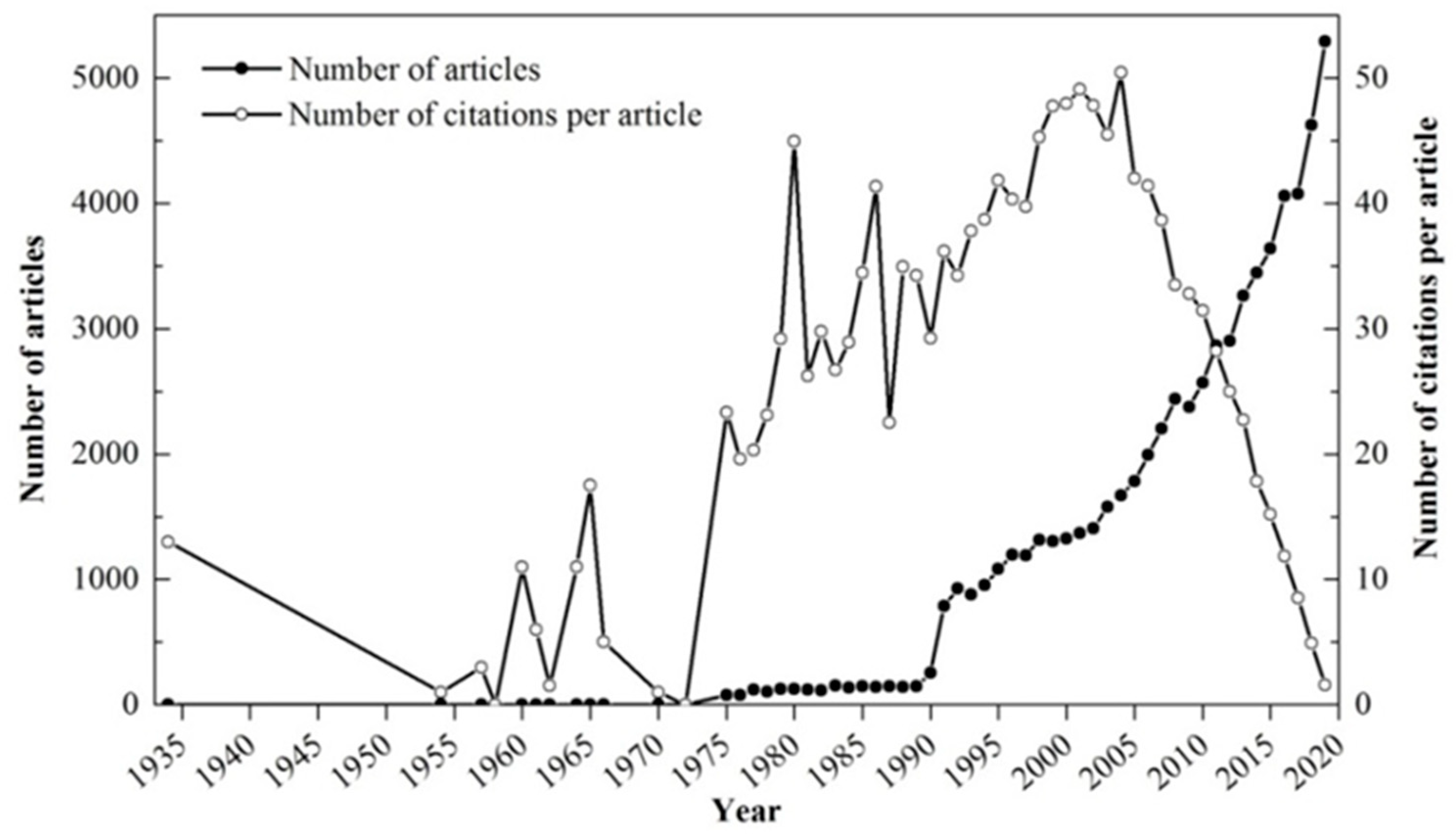
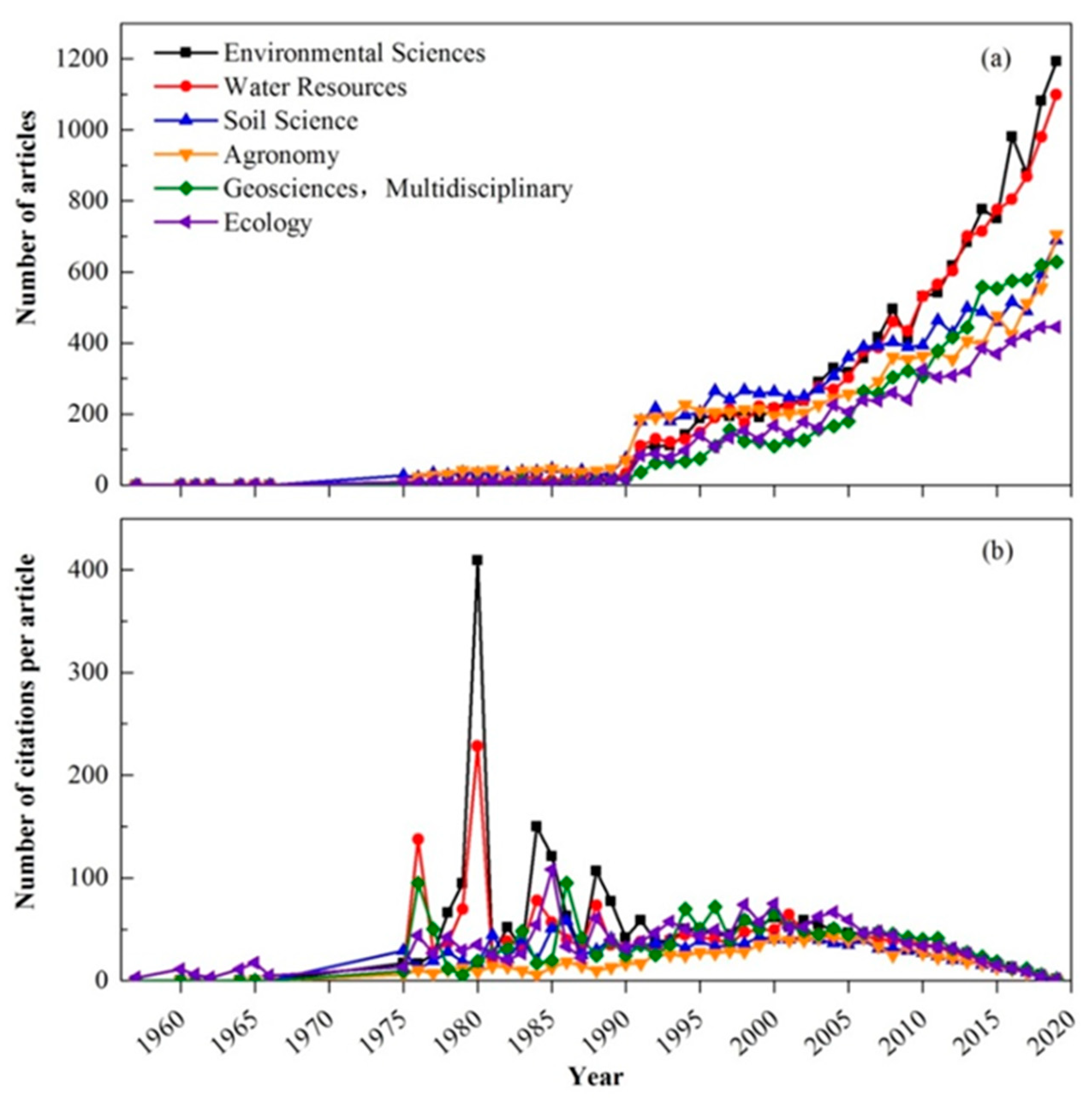
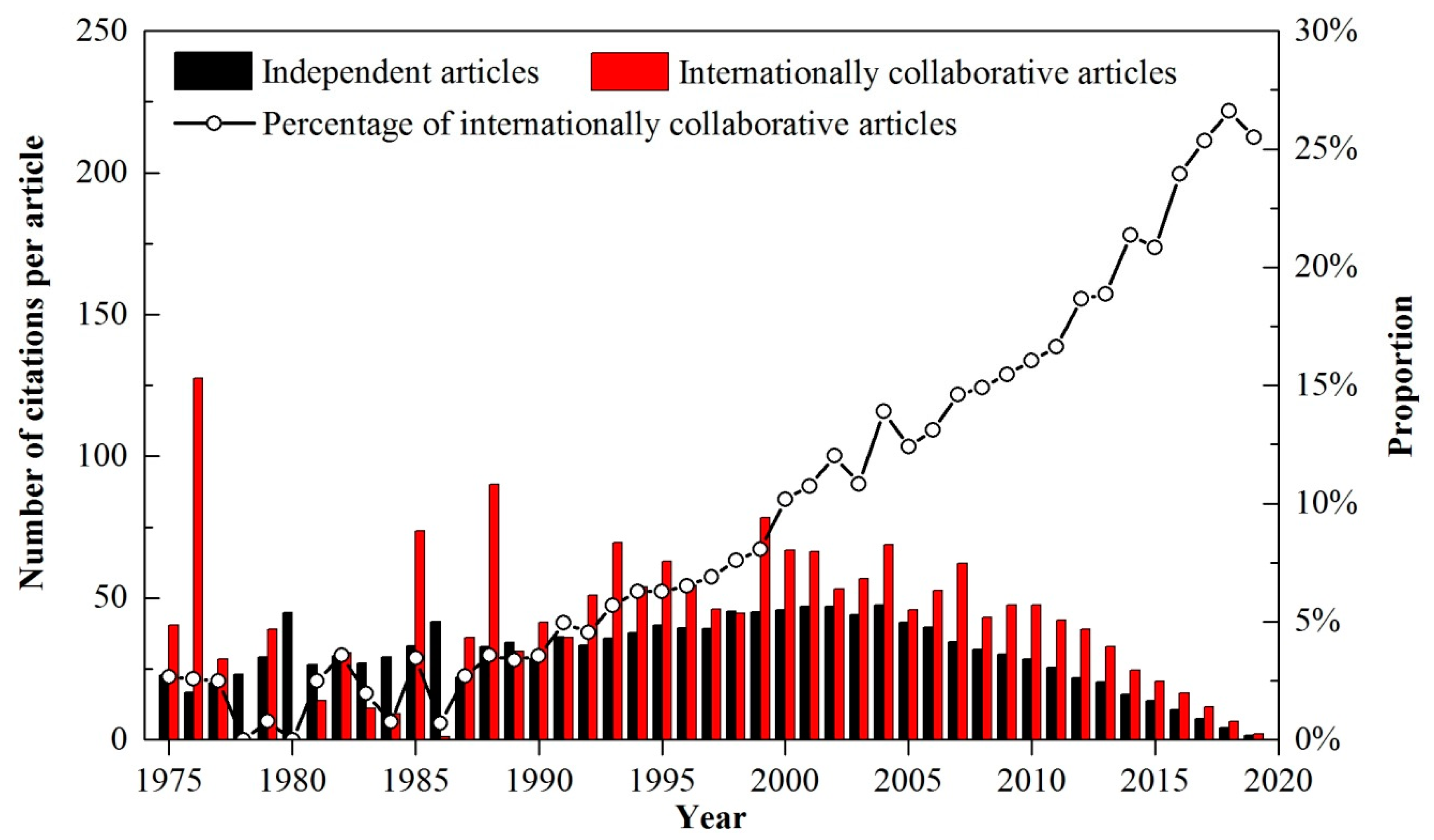
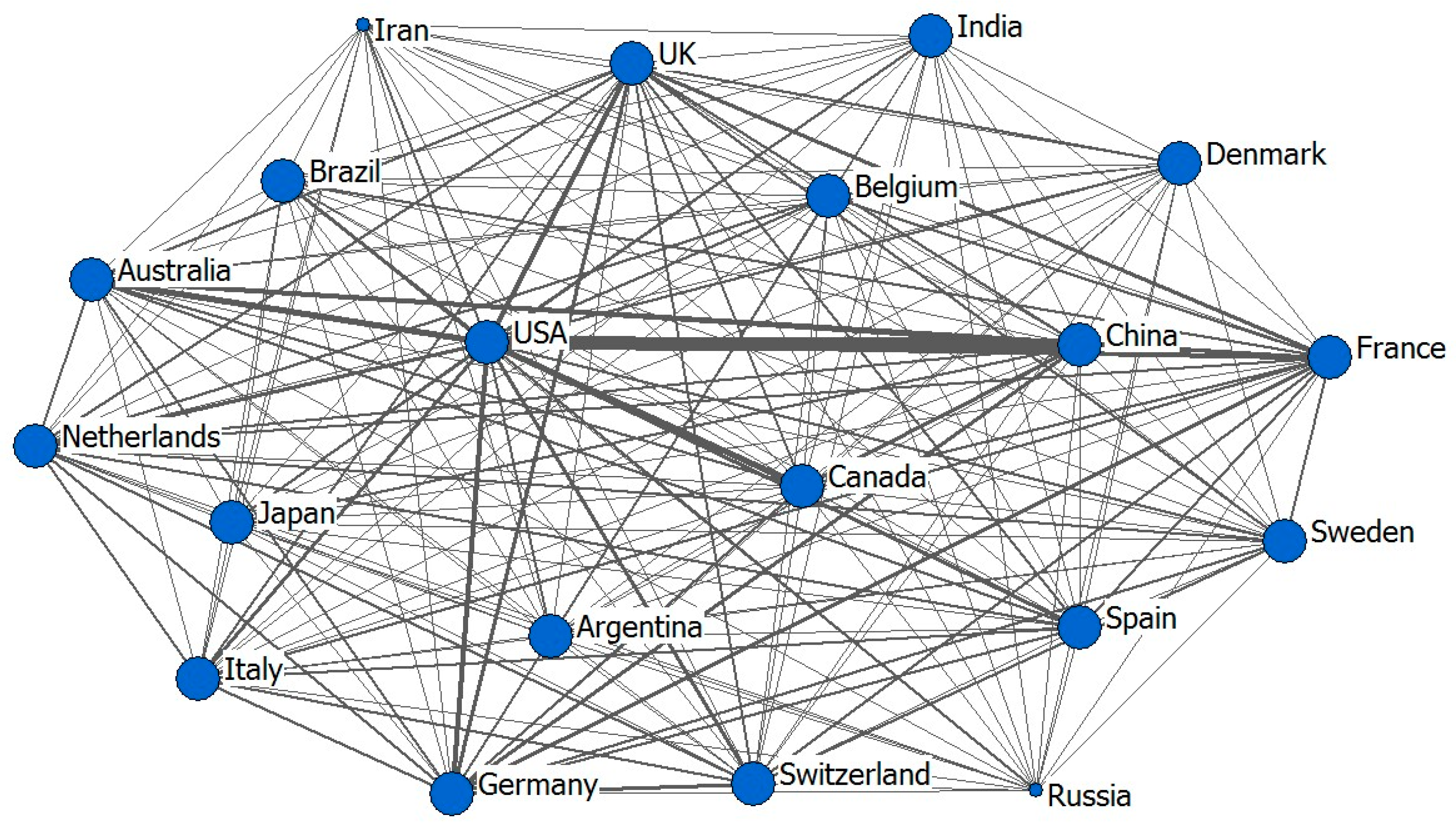
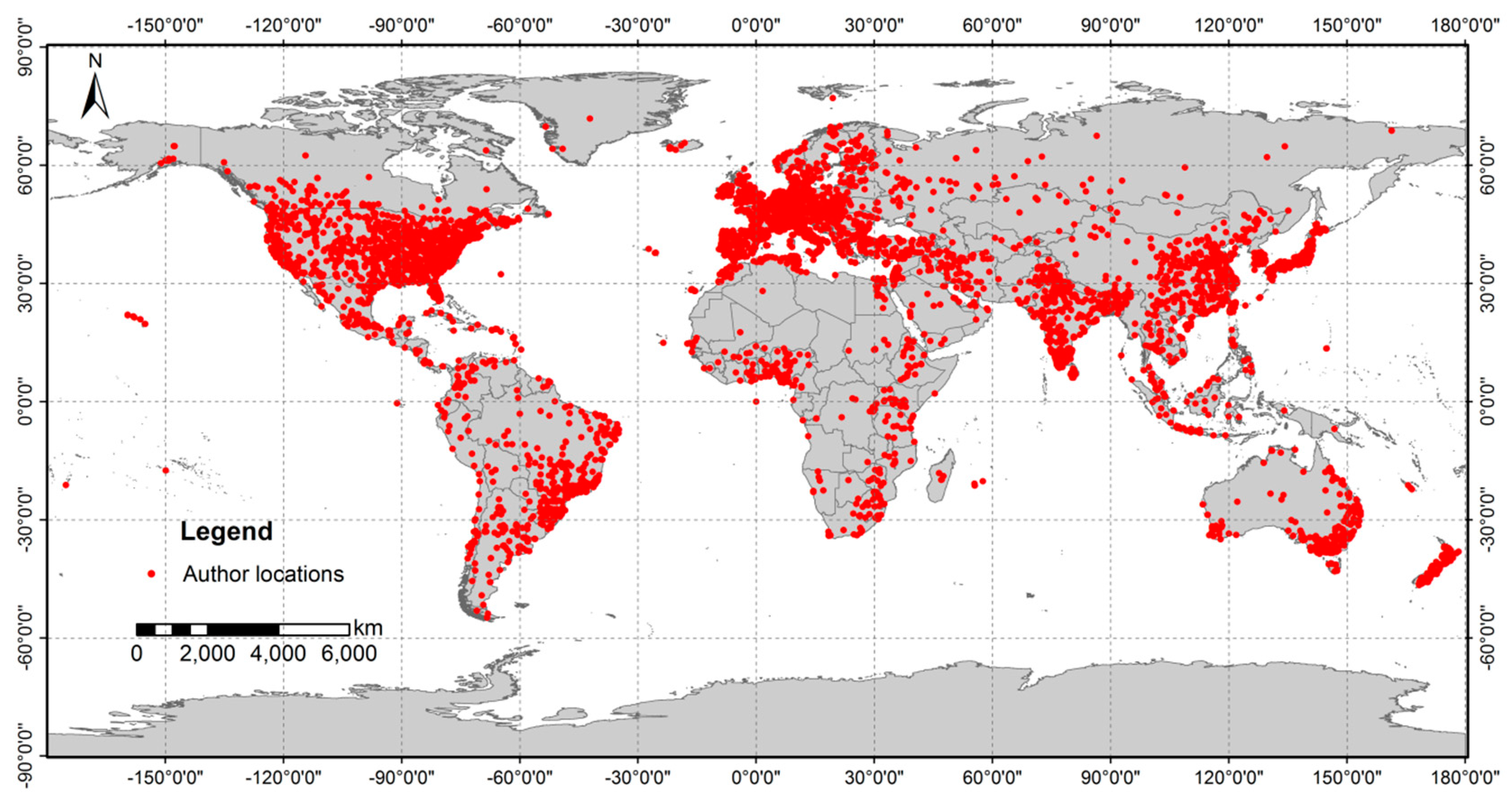
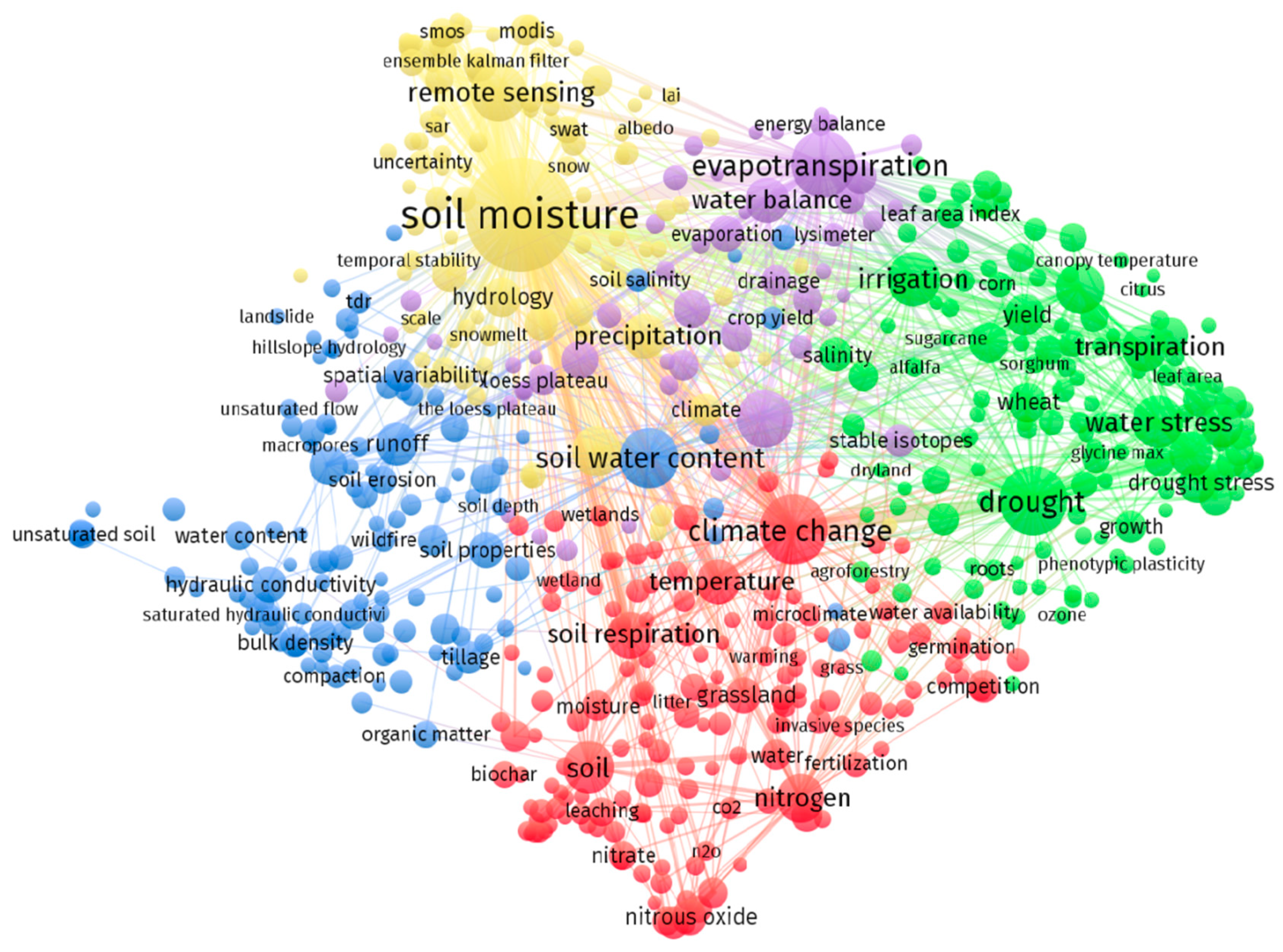
| Year | TA | TA (%) | TU | TU/TA | TR | TR/TA | TP | TP/TA | TC | TC/TA |
|---|---|---|---|---|---|---|---|---|---|---|
| 1934–1949 | 1 | 0.002 | 1 | 1.00 | 5 | 5.00 | 26 | 26.00 | 13 | 13.00 |
| 1950–1959 | 3 | 0.005 | 4 | 1.33 | 38 | 12.67 | 24 | 8.00 | 4 | 1.33 |
| 1960–1969 | 8 | 0.012 | 14 | 1.75 | 171 | 21.38 | 51 | 6.38 | 71 | 8.88 |
| 1970–1979 | 508 | 0.762 | 1068 | 2.10 | 6499 | 12.79 | 3937 | 7.75 | 11,870 | 23.37 |
| 1980–1989 | 1366 | 2.049 | 3200 | 2.34 | 23,107 | 16.92 | 12,502 | 9.15 | 44,121 | 32.30 |
| 1990–1999 | 9888 | 14.836 | 28,992 | 2.93 | 275,359 | 27.85 | 109,727 | 11.10 | 400,386 | 40.49 |
| 2000–2009 | 18,139 | 27.216 | 68,041 | 3.75 | 679,885 | 37.48 | 208,288 | 11.48 | 756,065 | 41.68 |
| 2010–2019 | 36,735 | 55.118 | 179,309 | 4.88 | 1,873,810 | 51.01 | 454,358 | 12.37 | 539,021 | 14.67 |
| Total | 66,648 | 280,629 | 2,858,874 | 788,913 | 175,1551 | |||||
| Average | 4.21 | 42.90 | 11.84 | 26.28 |
| Journal Title | TA | TA (%) | TC | TC (%) | TC/TA |
|---|---|---|---|---|---|
| Journal of Hydrology | 1821 | 2.73 | 65,683 | 3.75 | 36.07 |
| Agricultural Water Management | 1497 | 2.25 | 35,634 | 2.03 | 23.80 |
| Water Resources Research | 1479 | 2.22 | 77,002 | 4.40 | 52.06 |
| Soil Science Society of America Journal | 1308 | 1.96 | 51,695 | 2.95 | 39.52 |
| Hydrological Processes | 1066 | 1.60 | 30,318 | 1.73 | 28.44 |
| Plant and Soil | 976 | 1.46 | 30,955 | 1.77 | 31.72 |
| Agricultural and Forest Meteorology | 896 | 1.34 | 35,789 | 2.04 | 39.94 |
| Geoderma | 872 | 1.31 | 24,610 | 1.41 | 28.22 |
| Hydrology and Earth System Sciences | 863 | 1.29 | 25,940 | 1.48 | 30.06 |
| Soil & Tillage Research | 810 | 1.22 | 24,486 | 1.40 | 30.23 |
| Journal of Geophysical Research-Atmospheres | 806 | 1.21 | 38,896 | 2.22 | 48.26 |
| Forest Ecology and Management | 754 | 1.13 | 23,646 | 1.35 | 31.36 |
| Agronomy Journal | 726 | 1.09 | 20,894 | 1.19 | 28.78 |
| IEEE Transactions on Geoscience and Remote Sensing | 694 | 1.04 | 31,137 | 1.78 | 44.87 |
| Vadose Zone Journal | 663 | 0.99 | 13,093 | 0.75 | 19.75 |
| Soil Biology & Biochemistry | 658 | 0.99 | 34,814 | 1.99 | 52.91 |
| Science of the Total Environment | 657 | 0.99 | 11,130 | 0.64 | 16.94 |
| Remote Sensing of Environment | 645 | 0.97 | 36,860 | 2.10 | 57.15 |
| Journal of Hydrometeorology | 628 | 0.94 | 26,673 | 1.52 | 42.47 |
| Remote Sensing | 590 | 0.89 | 5472 | 0.31 | 9.27 |
| Institution | Country | TA | TC | TC/TA |
|---|---|---|---|---|
| Chinese Academy of Sciences | China | 4761 | 91,891 | 19.30 |
| USDA ARS | USA | 2858 | 101,305 | 35.45 |
| University of Chinese Academy of Sciences | China | 1133 | 10,610 | 9.36 |
| INRA | France | 952 | 39,491 | 41.48 |
| NASA | USA | 839 | 53,763 | 64.08 |
| University of California, Davis | USA | 745 | 28,077 | 37.69 |
| University of Florida | USA | 730 | 17,221 | 23.59 |
| University of Arizona | USA | 727 | 38,678 | 53.20 |
| Northwest A&F University | China | 683 | 6955 | 10.18 |
| China Agricultural University | China | 674 | 11,841 | 17.57 |
| Beijing Normal University | China | 641 | 11,553 | 18.02 |
| Colorado State University | USA | 638 | 28,323 | 44.39 |
| CSIC | Spain | 628 | 21,214 | 33.78 |
| Texas A&M University | USA | 583 | 16,831 | 28.87 |
| Agriculture and Agri-Food Canada | Canada | 582 | 13,686 | 23.52 |
| US Geological Survey | USA | 568 | 27,193 | 47.88 |
| Oregon State University | USA | 548 | 22,378 | 40.84 |
| CSIRO | Australia | 534 | 27,967 | 52.37 |
| University of Nebraska | USA | 529 | 15,777 | 29.82 |
| US Forest Service | USA | 524 | 18,793 | 35.86 |
| Country | TA | TC/TA | IA | IA (%) | IC/IA | CA | CA (%) | CC/CA |
|---|---|---|---|---|---|---|---|---|
| USA | 23,238 | 34.70 | 17,917 | 77.10 | 35.27 | 5321 | 22.90 | 32.79 |
| China | 10,832 | 15.49 | 7999 | 73.85 | 13.73 | 2833 | 26.15 | 20.46 |
| Australia | 4057 | 31.13 | 2660 | 65.57 | 28.61 | 1397 | 34.43 | 35.94 |
| Germany | 3868 | 28.68 | 2195 | 56.75 | 24.68 | 1673 | 43.25 | 33.92 |
| Canada | 3864 | 28.87 | 2746 | 71.07 | 27.26 | 1118 | 28.93 | 32.80 |
| UK | 3282 | 39.19 | 1822 | 55.51 | 37.81 | 1460 | 44.49 | 40.91 |
| France | 3059 | 36.76 | 1629 | 53.25 | 35.51 | 1430 | 46.75 | 38.18 |
| Spain | 2389 | 30.13 | 1508 | 63.12 | 28.66 | 881 | 36.88 | 32.63 |
| India | 2385 | 12.26 | 2055 | 86.16 | 11.57 | 330 | 13.84 | 16.52 |
| Brazil | 2270 | 15.75 | 1711 | 75.37 | 10.18 | 559 | 24.63 | 32.79 |
| Italy | 2144 | 32.10 | 1343 | 62.64 | 25.12 | 801 | 37.36 | 43.80 |
| Japan | 2062 | 20.34 | 1398 | 67.80 | 17.17 | 664 | 32.20 | 27.03 |
| Netherlands | 1749 | 42.66 | 753 | 43.05 | 39.32 | 996 | 56.95 | 45.18 |
| Switzerland | 1175 | 38.02 | 517 | 44.00 | 37.47 | 658 | 56.00 | 38.45 |
| Sweden | 984 | 34.33 | 503 | 51.12 | 31.69 | 481 | 48.88 | 37.08 |
| Iran | 902 | 10.98 | 668 | 74.06 | 9.65 | 234 | 25.94 | 14.77 |
| Belgium | 884 | 36.02 | 386 | 43.67 | 32.69 | 498 | 56.33 | 38.61 |
| Denmark | 802 | 36.79 | 423 | 52.74 | 35.46 | 379 | 47.26 | 38.27 |
| Argentina | 704 | 23.63 | 492 | 69.89 | 18.09 | 212 | 30.11 | 36.48 |
| Russia | 632 | 14.67 | 427 | 67.56 | 4.99 | 205 | 32.44 | 34.85 |
| Keywords | 1990–1999 | 2000–2009 | 2010–2019 | 1990–2019 | ||||
|---|---|---|---|---|---|---|---|---|
| F | R | F | R | F | R | F | R | |
| Soil moisture | 399 | 1 | 1344 | 1 | 3260 | 1 | 5003 | 1 |
| Climate change | 62 | 23 | 294 | 6 | 1308 | 2 | 1664 | 2 |
| Drought | 140 | 6 | 389 | 4 | 1128 | 3 | 1657 | 3 |
| Evapotranspiration | 114 | 8 | 453 | 2 | 920 | 4 | 1487 | 4 |
| Soil water content | 96 | 12 | 343 | 5 | 759 | 5 | 1198 | 5 |
| Soil water | 185 | 2 | 398 | 3 | 509 | 9 | 1092 | 6 |
| Remote sensing | 46 | 38 | 263 | 9 | 733 | 6 | 1042 | 7 |
| Irrigation | 132 | 7 | 283 | 7 | 518 | 8 | 933 | 8 |
| Soil | 151 | 4 | 278 | 8 | 437 | 11 | 866 | 9 |
| Water stress | 174 | 3 | 236 | 12 | 432 | 12 | 842 | 10 |
| Water use efficiency | 61 | 25 | 193 | 19 | 522 | 7 | 776 | 11 |
| Soil temperature | 80 | 15 | 215 | 14 | 466 | 10 | 761 | 12 |
| Nitrogen | 145 | 5 | 250 | 10 | 308 | 20 | 703 | 13 |
| Transpiration | 114 | 8 | 241 | 11 | 332 | 15 | 687 | 14 |
| Soil respiration | 35 | 55 | 210 | 15 | 393 | 14 | 638 | 15 |
| Photosynthesis | 111 | 10 | 207 | 16 | 312 | 19 | 630 | 16 |
| Temperature | 83 | 14 | 205 | 17 | 322 | 18 | 610 | 17 |
| Water balance | 80 | 15 | 201 | 18 | 323 | 17 | 604 | 18 |
| Precipitation | 26 | 82 | 131 | 25 | 424 | 13 | 581 | 19 |
| Stomatal conductance | 105 | 11 | 217 | 13 | 250 | 26 | 572 | 20 |
© 2020 by the authors. Licensee MDPI, Basel, Switzerland. This article is an open access article distributed under the terms and conditions of the Creative Commons Attribution (CC BY) license (http://creativecommons.org/licenses/by/4.0/).
Share and Cite
Zhang, H.; Liu, X.; Yi, J.; Yang, X.; Wu, T.; He, Y.; Duan, H.; Liu, M.; Tian, P. Bibliometric Analysis of Research on Soil Water from 1934 to 2019. Water 2020, 12, 1631. https://doi.org/10.3390/w12061631
Zhang H, Liu X, Yi J, Yang X, Wu T, He Y, Duan H, Liu M, Tian P. Bibliometric Analysis of Research on Soil Water from 1934 to 2019. Water. 2020; 12(6):1631. https://doi.org/10.3390/w12061631
Chicago/Turabian StyleZhang, Hailin, Xiuyun Liu, Jun Yi, Xiufeng Yang, Tieniu Wu, Yi He, He Duan, Muxing Liu, and Pei Tian. 2020. "Bibliometric Analysis of Research on Soil Water from 1934 to 2019" Water 12, no. 6: 1631. https://doi.org/10.3390/w12061631
APA StyleZhang, H., Liu, X., Yi, J., Yang, X., Wu, T., He, Y., Duan, H., Liu, M., & Tian, P. (2020). Bibliometric Analysis of Research on Soil Water from 1934 to 2019. Water, 12(6), 1631. https://doi.org/10.3390/w12061631






